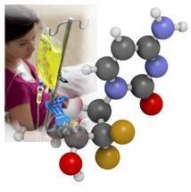Chemotherapy Overview
Medically Reviewed by Sreenivas V. Rao, MD
Along with surgery and radiation therapy, chemotherapy – the use of powerful drugs to attack cancer cells – is one of the main treatments available to cancer patients.
“Chemotherapy involves using a specific drug or one combination of several of the more than 100 now used, depending on the specific goal of treatment,” says McLeod Oncologist Dr. Sreenivas Rao. “Not only is the specific mix of drugs important, but also the order in which the patient receives the drugs is critical. Sometimes chemo is given alone. Other times, it’s part of the treatment along with surgery or radiation therapy.”
Goals of Chemotherapy
Obviously, the patient hopes that the chemo will kill the cancer cells, curing the patient. But that’s not the only reason cancer specialists employ this tool. Other goals are:
- Controlling cancer
- Killing cancer cells that may have spread to another site in the patient’s body.
- Shrinking cancer cells before surgery.
- Killing any remaining cancer cells after radiation therapy or surgery.
- Limiting the cancer’s spread or slowing the growth.
- Relieving cancer symptoms by shrinking tumors that cause pain or pressure.
Delivering the Chemo
Most people receive their chemotherapy near home in a specialty center, such as the McLeod Center for Cancer Treatment and Research. Some patients receive chemo treatments in a special clinic, their doctor’s office or at home.
The liquid drug cocktail can be delivered through a catheter directly into a vein, an artery, or a body cavity – such as the peritoneal cavity, which contains the ovaries, intestines, liver and stomach.
To prevent damage to veins and to make chemo delivery easier, patients are often surgically fitted with a catheter or port where the needle is inserted.
Injections and pills, along with creams that are rubbed into the skin, are also used to administer the chemotherapy.
Timing, Cycles
Depending on the extent and type of the cancer, the patient’s response to the drugs and the goals of treatment, patients may receive treatment daily, weekly or monthly. A single treatment can take from 3-minutes to 3 hours. Continuous infusion – where a pump delivers chemo – can last 1 to 5 days.
Due to the toll that the drugs impose on the body, chemotherapy is usually given in “cycles.” The patient receives treatments every week or less frequently and then rests for a week or more before undertaking another series of chemotherapy treatments.
Side Effects
Cancer treatment can cause a wide range of side effects. See our article covering many of these problems. Chemotherapy is designed to kill cancer cells. By doing so it decreases your body’s ability to fight infection. It’s important to stay away from sick people and crowds, brush your teeth after meals, wash your hands after handling meat, try not to cut yourself when shaving, and clean carefully and completely after going to the bathroom
To learn more about chemotherapy treatments and side effects, visit The American Cancer Society
Sources include: McLeod Health, National Institutes of Health, National Cancer Institute, British Lung Foundation, British Journal of Cancer, American Cancer Society
-
McLEOD REGIONAL MEDICAL CENTER FLORENCE
843-777-2000 -
McLEOD DARLINGTON
843-777-1100 -
McLEOD DILLON
843-774-4111 -
McLEOD LORIS
843-716-7000 -
McLEOD SEACOAST
843-390-8100 -
McLEOD CHERAW
843-537-7881 -
McLEOD CLARENDON
803-433-3000



-
McLEOD REGIONAL MEDICAL CENTER FLORENCE
843-777-2000 -
McLEOD DARLINGTON
843-777-1100 -
McLEOD DILLON
843-774-4111 -
McLEOD LORIS
843-716-7000 -
McLEOD SEACOAST
843-390-8100 -
McLEOD CHERAW
843-537-7881 -
McLEOD CLARENDON
803-433-3000
 Find a Doctor
Find a Doctor  Locations
Locations  Services
Services 